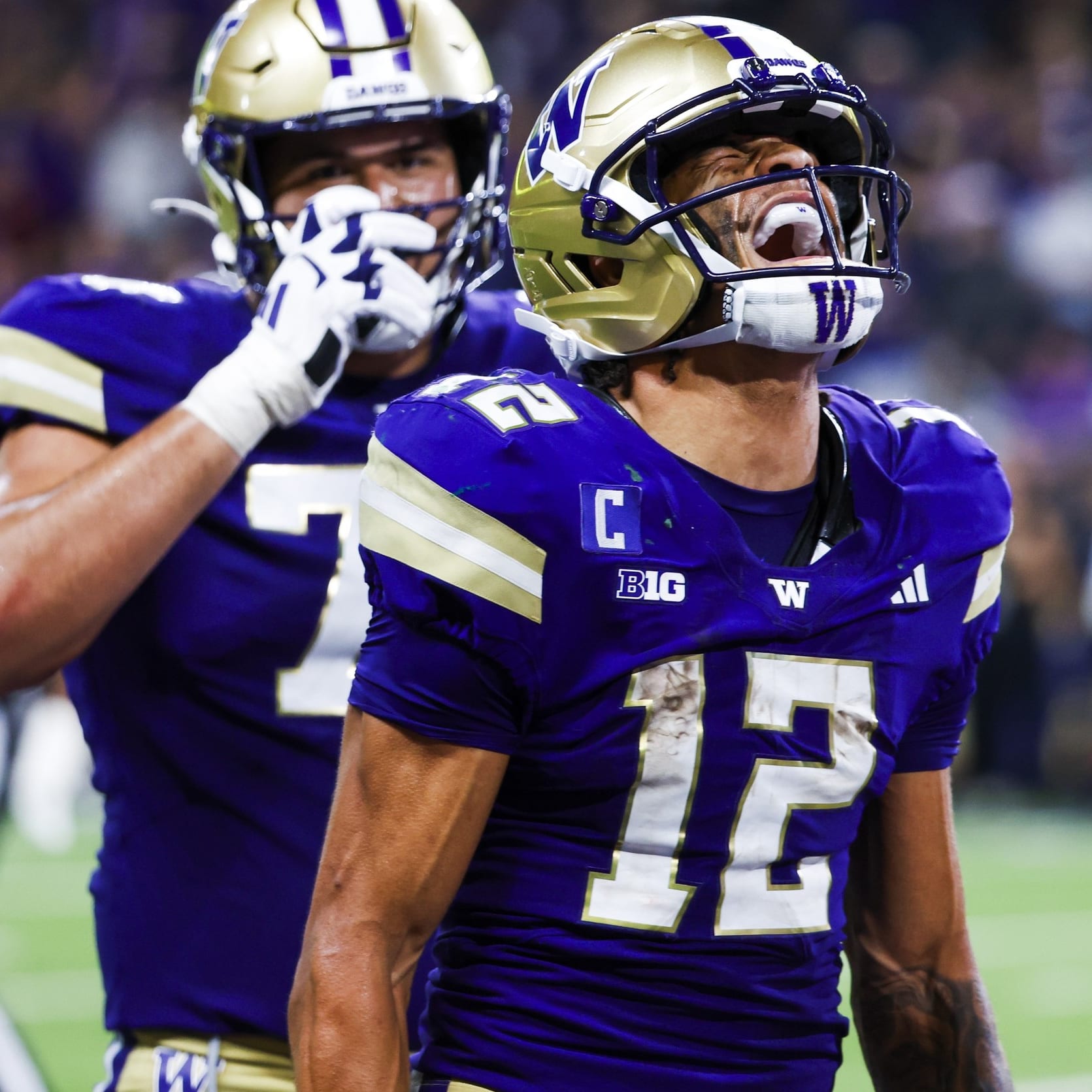If you play in a dynasty or Ottoneu format in fantasy football, you're probably already wondering about the upcoming class of rookies and how you might want to add on to your current roster heading into next year. John McKechnie and I aggregated our personal rankings into a combined list where we break down who we think the top fantasy assets are among prospects eligible for the 2018 draft.
When projecting for fantasy utility you most basically need to account for age-adjusted production and size-adjusted athleticism. You also need to project for opportunity, which most reliably correlates to draft projection – players picked early tend to get more chances to play early, if only because teams are more materially invested in a player the earlier they select them. So, making a list like this is tricky when we don't know which underclassmen might declare for the draft. Nick Chubb and Royce Freeman were both blue chip dynasty assets last year, but their owners were probably a tad bitter when both returned to school instead of heading to the NFL. Such is the risk of any player on this listed with an asterisk, denoting their underclass status. The sword cuts both ways, of course – underclassmen tend to be the most talented players in any give class. We do our best to account for all these variables with the following rankings.
Keep a lookout for us eventually rolling out a cheatsheet for year-round NFL dynasty rankings of college players.
1. Saquon
If you play in a dynasty or Ottoneu format in fantasy football, you're probably already wondering about the upcoming class of rookies and how you might want to add on to your current roster heading into next year. John McKechnie and I aggregated our personal rankings into a combined list where we break down who we think the top fantasy assets are among prospects eligible for the 2018 draft.
When projecting for fantasy utility you most basically need to account for age-adjusted production and size-adjusted athleticism. You also need to project for opportunity, which most reliably correlates to draft projection – players picked early tend to get more chances to play early, if only because teams are more materially invested in a player the earlier they select them. So, making a list like this is tricky when we don't know which underclassmen might declare for the draft. Nick Chubb and Royce Freeman were both blue chip dynasty assets last year, but their owners were probably a tad bitter when both returned to school instead of heading to the NFL. Such is the risk of any player on this listed with an asterisk, denoting their underclass status. The sword cuts both ways, of course – underclassmen tend to be the most talented players in any give class. We do our best to account for all these variables with the following rankings.
Keep a lookout for us eventually rolling out a cheatsheet for year-round NFL dynasty rankings of college players.
1. Saquon Barkley, RB, Penn State*
Barkley has been viewed as a future first-rounder since his freshman year and he's lived up to that billing with three electric seasons. The raw numbers in 2017 (1,134 yards, 16 touchdowns) may not be as good as they were in 2016 (1,496/18), but Barkley actually ran more effectively (5.7 YPC) and showed the type of improvement as a pass catcher -- 47 catches on 61 targets for 594 yards and three touchdowns -- to cement his billing as a three-down back in the NFL. Barkley also ran two kicks back for touchdowns this season. What sets Barkley apart is his blend of size and athleticism; checking in at 5-11, 228, Barkley has the Penn State record for the power clean (405 lb) and ran an unofficial 4.33 in the 40 yard dash past summer. -John
2. Derrius Guice, RB, LSU*
What was supposed to be Guice's breakout year in 2017 was complicated by injuries, but he's still one of the top running back prospects of recent memory. His general nature might be most comparable to Dalvin Cook – this is a back with uncommon burst and change-of-direction ability who should be among the best big-play threats at running back in the NFL. Look at it this way: Guice's 2017 season was a major disappointment even though he totaled 1,153 yards (5.3 YPC) and 11 touchdowns in 11 games. That's because Guice (5-foot-11, 218 pounds) was incomparably explosive the two prior years, when he totaled 1,823 yards and 18 touchdowns on just 234 carries (7.8 YPC). Prior to his disappointing 2017 regular season, it wasn't uncommon for draft observers to theorize that Guice might be an even better prospect than Leonard Fournette. -Mario
3. Nick Chubb, RB, Georgia
Chubb's career began with the look of a star in the making after rushing for 1,547 yards (7.1 YPC) and 14 scores as a true freshman, but a devastating knee injury in his sophomore year altered his path. He ran well in his 2016 return, but still wasn't close to his old form. His decision to return for his senior year garnered some skeptics, but Chubb's 2017 confirmed that he's back to his pre-injury self as he ran for 1,092 yards and 13 scores and showed renewed burst and flexion in addition to his already elite vision. With two years of injury-free success under his belt post-2015, Chubb (5-11, 225) now heads to the NFL with an improved draft stock from a year ago. Chubb's wear-and-tear will be scrutinized throughout the draft process, but he's a thickly built and powerful runner who can translate into a starter at the next level. -John
4. Damien Harris, RB, Alabama*
A glance at Harris' raw numbers won't blow anyone away, but when you bake in the team context where Alabama had a running quarterback to go with a stable of other blue chip running backs, his production is impressive. Harris had two more carries than counterpart Bo Scarbrough this year, yet 357 more rushing yards. Harris (5-foot-11, 214 pounds) runs with good pad level, and he possesses quality burst as well. What sets Harris apart is his cutting ability and balance. An elite prospect coming out of high school, Harris should open the eyes of his doubters at the Combine as he'll be one of the top performers across the board in his position group. If Harris tests as well as his film and pedigree suggest he will, he could garner Day 1 consideration. -John
5. James Washington, WR, Oklahoma State
Washington appears as fast and quick as pretty much any receiver in his class, and his superb production bodes well since he's done all of it under the age of 22. He doesn't project as a WR1 at a listed 6-feet, 205 pounds, but Washington could project for 1,300-yard upside even as a WR2 if his athletic testing checks the boxes at the Combine. Washington has been preposterously productive the last two years, turning 243 targets into 2,803 yards (11.5 YPT) and 22 touchdowns in 25 games. He posted 1,087 yards and ten touchdowns as a sophomore before that. If he tests well enough at the Combine, Washington could project as a bigger T.Y. Hilton. -Mario
6. Josh Adams, RB, Notre Dame*
Adams generally wasn't regarded as highly as the likes of Barkley, Guice, Chubb, Harris, or even Royce Freeman before this year, but an extremely explosive breakout season has put him on the map as a legitimate blue chip talent at running back. Bigger than most backs at a listed 6-foot-2, 225 pounds, Adams' remarkably explosive production implies he'll likely test much better than the average at the Combine, too. If Adams can prove an athletic standout at that frame, a projection like Deuce McAllister might be in his future. Adams torched defenses for 1,386 yards (7.3 YPC) and nine touchdowns in 12 games this year, giving him a career total of 3,157 yards (6.8 YPC) and 20 touchdowns in 36 games at Notre Dame. Only poor athletic testing would keep him out of the draft's second day. -Mario
7. Calvin Ridley, WR, Alabama*
Skill, speed, hands, intelligence: Ridley has elite levels of each. He's not a perfect prospect, however. Age is an issue as he turned 21 during his freshman season and will be a 23-year-old rookie. Ridley is also slight, listed at 190. Still, his size hasn't kept him from producing at the highest collegiate level. He averaged just 6.6 YPT as a sophomore, but responded with 10.3 YPT this year. While Ridley's touchdowns dropped from seven to three, some of that can be explained by game flow and team context. Ridley is a cerebral player; he knows where to find the soft spots in coverage and he knows how to get the most out of his yards after catch. Physical corners who press him will be a challenge for Ridley considering his size, but his elite attributes in other areas will compensate for that. He profiles as a strong No.2 receiver at the next level. -John
8. Lamar Jackson, QB, Louisville*
Even if Jackson isn't the first quarterback selected, he's the clearly top quarterback to target for fantasy purposes. Indeed, his enormous talent is particularly suited to fantasy production, since he's likely the best runner of any quarterback ever to play. Jackson is something like Gale Sayers as a runner, and he has a good arm that generates strong velocity on a low-effort delivery. This is a player who, for all his notoriety, is overlooked as a prospect. There hasn't been one like Jackson before. Vince Young and Michael Vick are probably the closest comparisons, yet Jackson is more athletic than Young and far more productive than either. Both with regard to passing and running, Jackson was better than Young or Vick. -Mario
9. Sony Michel, RB, Georgia
Michel arrived at Georgia ranked just behind the likes of Leonard Fournette and Dalvin Cook as one of the top running backs in the nation, but classmate Nick Chubb quickly seized the No. 1 role for the Dawgs. After three unfulfilling years, Michel opted to go back for his senior year and it has proven to be the right choice. Michel (5-11, 215) erupted for 7.3 YPC and 13 touchdowns on 124 carries in 2017, vaulting him into the upper crest of running back prospects. He's always had speed and balance in his arsenal, but Michel's improved pad level in 2017 has turned him into a more powerful runner as well. While he will be a 23-year-old rookie, Michel has relatively little wear and tear for a four-year player. -John
10. Rashaad Penny, RB, San Diego State
Donnel Pumphrey left some big shoes to fill at San Diego State, but Penny was not only ready for the task, but he actually proved even better than Pumphrey, one of college football's all-time best players and an eventual fourth-round pick of the Eagles. Not only is Penny (5-foot-11, 220) much bigger than Pumphrey, but he's also been more explosive. Penny ran for 2,027 yards and 19 touchdowns on 275 carries this year, good for an average of 7.4 yards per carry. He also returned two kickoffs and one punt for touchdowns. Penny is one of the best kick returners in college football history with seven returned for touchdowns – an unusual skill for a 220-pound back. He can catch, too. -Mario
11. Christian Kirk, WR, Texas A&M*
Kirk arrived to Texas A&M in 2015 as the latest in a long group of heralded wide receivers – Josh Reynolds, Ricky Seals-Jones, and Speedy Noil were all hyped commodities – yet he proved the best one from Day 1. That Kirk outproduced those players as an 18-year-old, totaling 80 receptions for 1,009 yards and seven touchdowns, bodes very well for his long-term upside projection. That Kirk was a lethal punt returner in college, averaging 22.8 yards per return and scoring six times on 35 attempts, indicates that he has unique YAC potential. Kirk doesn't have a solid WR1 projection at 5-foot-11, 200 pounds, but his ability to outplay older NFL talents from the very start of his college career hints at upside greater than his frame would normally dictate. He shouldn't be ruled out as a candidate to be the first receiver selected. -Mario
12. Jaylen Smith, WR, Louisville*
Smith doesn't have as much mainstream recognition as players like Washington, Ridley, Kirk, or even a handful of receivers listed lower than him in these rankings, but his prospect profile indicates he's one of the few receivers eligible for the upcoming draft with the traits to potentially turn into a WR1 in the NFL. Listed at 6-foot-4, 219 pounds, he should check in at 6-foot-3, 220 pounds for his eventual Combine weigh-in. He won't turn 21 until August, yet Smith has been dominant over the last two seasons, converting 137 targets into 1,472 yards (10.8 YPT) and 12 touchdowns. It would be a surprise if he returned for his senior season with Lamar Jackson likely leaving for the NFL.
13. Royce Freeman, RB, Oregon
Some may understandably find concern in the workload Freeman has seen since he's a power back and four-year starter who's already taken on 1,026 touches from scrimmage. It's resulted in some nagging injuries the last two years, as well. But when healthy, Freeman is an absolute tank and a skilled workhorse back. Listed at 6-feet, 238 pounds, Freeman shows no stiffness or slowness despite his big build. Over the last four years he's run for 5,621 yards (5.9 YPC) and 60 touchdowns in 51 games, and he shows standout pass-catching ability with 79 receptions for 814 yards and four more touchdowns. As long as he runs a 4.60 or better at the Combine, the third round should be his floor. -Mario
14. Bryce Love, RB, Stanford*
Love (5-foot-10, 196 pounds) probably doesn't project as a starter in the NFL, but as a versatile and supremely elusive runner he should at least be able to carve out a Duke Johnson-like role early on in his career. A renown track prodigy, Love should murder the Combine after earning track notoriety as early as age 12. That explosiveness has shown up reliably on the field, as he posted an incredible 1,973 yards (8.3 YPC) and 17 touchdowns in 2017, giving him 2,981 yards (7.9 YPC) and 22 touchdowns over 37 career games. -Mario
15. Courtland Sutton, WR, SMU
Sutton looks like he might only run in the 4.60-4.65 range in the 40-yard dash, which would damper his projection for WR1 upside despite his enormous 6-foot-4, 216-pound frame. His prospect luster also might have lessened a bit in the last year due to the emergence of fellow SMU receiver Trey Quinn – after far and away leading SMU's receiving production in 2015 and 2016, Sutton saw Quinn emerge as the team's leader in receptions and yardage, outpacing Sutton by 44 and 174 in those fields, respectively, while tying Sutton's team lead of 12 receiving touchdowns. Still, Sutton finished with 1,017 yards in his own right, and at the very least he projects as a good possession and red-zone target thanks to his ball skills and imposing build. Sutton plays with more flexibility and acrobatic ability than most receivers of his build, so he might be able to make a Kenny Golladay sort of impact as long as his workout numbers aren't problematic. -Mario
16. Equanimeous St. Brown, WR, Notre Dame*
Few prospects in college football have seen a 2017 season as frustrating as St. Brown's, as he headed into the year widely considered the top wideout in the class, but a down year has sent his stock spinning a bit. Still a safe Day 2 projection with first-round upside, St. Brown's biggest risk might be the uncertainty of whether he goes pro – the talent seems safe, but he might go back to school after a new quarterback and a neck/concussion injury harmed his production. Quarterback Brandon Wimbush was a much worse passer than DeShone Kizer before him, which helped precipitate ESB's drop from 961 yards and nine touchdowns in 2016 down to 468 yards and four touchdowns in 2017. An extremely lanky (6-foot-5, 203 pounds) target but one with the athleticism to threaten downfield, ESB is one of the few draft-eligible wideouts with WR1 upside, especially if he could add about 20 pounds to his frame. -Mario
17. Mark Andrews, TE, Oklahoma*
Andrews (6-foot-5, 254 pounds) is a big but highly athletic tight end who's been a hulking mismatch as a route runner since his first game at Oklahoma. He has 22 touchdowns on 108 career receptions, illustrating the menace he poses in the red zone. Over the last two years he's turned 123 targets into 1,395 yards (11.3 YPT) and 15 touchdowns, indicating unique upside as a pass catcher. The workout numbers of the top tight ends in this class will go a long way in sorting out their specific places, but Andrews' tape implies he'll be among the best in that regard. -Mario
18. Adam Breneman, TE, Massachusetts
Right behind Andrews is Breneman, a former top tight end recruit whose career was nearly derailed by knee issues before a recovery breakthrough led him to restart his career at Massachusetts after initially enrolling at Penn State. Breneman might be a year older than Andrews and he's otherwise behind the Oklahoma tight end due to said knee injury history. But Breneman has been dominant since his return, turning 204 targets into 1,572 yards and 12 touchdowns in his last 23 games. His production and pedigree give reason to suspect he'll test well at the Combine, and he should push for the second round if his knee checks out okay. -Mario
19. Ronald Jones, RB, USC*
Jones finally got to take over the lead running back role in 2017 after two years of frustrating usage patterns beyond his control. He took advantage of the opportunity, rushing 212 times for 1,346 yards and 16 touchdowns, which showed he's capable of holding up to a heavy workload. At 6-feet, 200 pounds, power isn't part of Jones' profile, but his speed is among the elite in this year's class. He's a home run hitter with 15 carries of 20-or-more yards this year, and a look at the tape shows that Jones has another gear once he reaches the second level. Jones is also young and won't be 21 until early in his first NFL training camp, so there's time for him to add mass in order to hold up better against NFL punishment. Speed will always be Jones' calling card and all indications are that he'll have one of the fastest 40's among running backs at the Combine. He'll need to demonstrate more pass catching and pass blocking ability to cut his teeth as a third down back to start his career, however. -John
20. D.J. Moore, WR, Maryland*
Who knows whether he will, but Moore should go pro after three strong seasons at Maryland, where he established himself as one of the nation's best open-field runners and a generally explosive target. Listed at 5-foot-11, 215 pounds, Moore doesn't have the height of a WR1 but his sturdy build would give him an advantageous projection among WR2 types if his athletic testing turns out well. On tape Moore shows a great deal of burst, balance, change-of-direction ability, and speed, so it would be a disappointment if he didn't test well. Despite playing with limited quarterbacks and their substantially worse backups over the last two years on a Maryland team ravaged by quarterback injuries, Moore turned 212 targets into 1,670 yards and 14 touchdowns. He's in the second and third-round conversation. -Mario
21. Jaylen Samuels, TE, North Carolina State
Samuels is a one-of-a-kind prospect whose profile contains a wide range of outcomes. That's mostly because we have no idea what position he'll play. Listed at 5-foot-11, 228 pounds, Samuels looks like a fullback but has played running back and tight end for the Wolfpack. If he maintains a tight end classification in the NFL, he could be a valuable loophole fantasy asset because he would in that case likely be a tight end in the Jordan Reed mold who also gets occasional carries out of the backfield. Over the last three years he's caught 188 passes for 1,709 yards and 18 touchdowns in 38 games, adding 944 yards (6.0 YPC) and 26 touchdowns on the ground. It's anyone guess whether he tests well enough to project for a similar role in the NFL, but Samuels is nothing if not versatile. The downside is his career could go the way of Marcel Reece. -Mario
22. Dallas Goedert, TE, South Dakota State
Listed at 6-foot-5, 260 pounds, Goedert has been a highly productive pass-catching tight end at the FCS level and heads into this offseason as one of the top-ranked fantasy prospects at the position. His athletic testing will hold crucial sway in his final projection, but in the meantime his film hints at a player with at least average athleticism, and the potential for more than that. He's been incredibly productive the last two years, catching 158 passes for 2,342 yards and 17 touchdowns in 25 games, so strong athletic testing could push him as high as the second round. Average or worse testing might put him on a Seth DeValve sort of trajectory. -Mario
23. Anthony Miller, WR, Memphis
Miller is a redshirt senior and a former walk-on, which don't bode well for his age-adjusted metrics or chances of testing well at the Combine, but despite whatever pedigree concerns with Miller, there's no questioning his production. He's been unstoppable the last two years, turning 280 targets into 187 receptions for 2,841 yards (10.2 YPT) and 31 touchdowns in 25 games. That includes big games against the tougher defenses on the schedule, including BCS opponents like UCLA, who saw Miller burn them for 185 yards and two touchdowns in 11 targets earlier this year. At a listed 5-foot-11, 190 pounds and potentially pushing 23 or 24 years old, Miller probably profiles as a third- or fourth-round pick despite his superb play. -Mario
24. Baker Mayfield, QB, Oklahoma
Mayfield isn't the prototype at a listed 6-foot-1, 220 pounds, which might prove closer to 6-feet, 220 pounds upon a Combine check-in, but his tape and production at Oklahoma say he's still a high first-round pick. He threw for 12,005 yards and 117 touchdowns in his last 39 games versus 20 interceptions, averaging 10.7 yards per pass. He's also a dangerous runner. There might be some concern to find in the fact that Mayfield left Texas Tech after the team chose to start Davis Webb, who's not particularly good, but recent history has made clear that this was just a monumental error on Texas Tech's part. -Mario
25. Auden Tate, WR, Florida State*
Tate doesn't show much separation on tape, but in terms of physical tools he's not easily distinguished from the more heralded Sutton. Listed at 6-foot-5, 225 pounds, Tate stands out for his ability to box out defenders and make contested catches in traffic. Shoulder and foot issues complicated his 2017 season and might give him reason to return to school, but if he declares for the draft he should project as a consideration in Rounds 2 through 4 after turning 101 targets into 873 yards and 13 touchdowns over the last two years. -Mario
26. Nyheim Hines, RB/WR, North Carolina State*
Hines primarily plays running back for North Carolina State, but at around 5-foot-9, 200 pounds he might be a sort of hybrid player between running back and wide receiver. He has ample pass-catching abilities, which could make him a slot matchup problem for defenses. Along with his versatility, Hines' selling point is his athleticism – he might be one of the fastest draft-eligible players, with suspected 4.3 speed. -Mario
27. Sam Darnold, QB, USC*
Darnold was the consensus favorite to be the first overall pick in the 2018 draft, and he still might do it, but the 2017 season generally raised more questions for Darnold than answers, and his stock has become more tenuous as a result. Still likely to be a top-ten pick, Darnold revealed a rougher skill set in 2017 than his excellent 2016 redshirt freshman season let on. But with good size, a strong arm, standout mobility and some moxie, NFL scouts will probably be able to look past Darnold's increased tendency for turnovers this year. If he does even out his game, Darnold's combination of arm and leg talent would give him significant fantasy upside. -Mario
28. Mike Gesicki, TE, Penn State
Gesicki doesn't have the pass-catching production of the tight ends listed ahead of him in these rankings, but at a listed 6-foot-6, 250 pounds with adequate production and good recruiting pedigree, he's a player who could push for the top at his position in this class if he tests well enough at the Combine. Over the last two years he's turned 143 targets into 99 receptions for 1,180 yards in 26 games, scoring 14 touchdowns in the process. -Mario
29. Ty Johnson, RB, Maryland*
Johnson (5-foot-11, 208 pounds) might be this year's Marlon Mack – an explosive running back whose talents may take some time to harness as he shifts into an NFL offense after playing in a college scheme with a very linear list of responsibilities. Like Mack at South Florida, Johnson's job was to wait for the zone-read execution and shoot out of a cannon if the handoff goes to him. Johnson was supremely explosive in this capacity, turning 282 carries over the last three years into 2,129 yards (7.5 YPC) and 14 touchdowns. He also flashed pass-catching ability with 23 receptions for 296 yards and two touchdowns in an offense that generally didn't throw much to the running backs. How he performs at the Combine will be crucial for his projection – as a player with a speed back skill set, he needs to demonstrate real speed and quickness for his game to translate. -Mario
30. Josh Rosen, QB, UCLA*
Rosen, from a pure passer perspective, may be the best in this class. There were concerns entering this year after Rosen missed the bulk of 2016 with a throwing shoulder injury. He quelled those concerns by completing 62.5 percent of his passes, averaging 337.9 yards per game, and tossing 26 touchdowns in 11 outings despite losing two of his best weapons. Rosen doesn't possess the rocket arm of a Josh Allen or Lamar Jackson, but he makes up for it with his accuracy, ball placement, and decision-making. His mechanics can fall off when he's under duress yet still manages to stand in and deliver a catchable ball more often than not. All told, Rosen has the tools to be a Matt Ryan type of quarterback who makes up for average arm strength with great accuracy, decision making, and pocket presence. -John
Honorable mentions, in no particular order: Deon Cain* (WR, Clemson), Quadree Henderson* (WR, Pittsburgh), Ray Lawry (RB, Old Dominion), Kerryon Johnson* (RB, Auburn), Akrum Wadley (RB, Iowa), Ito Smith (RB, Southern Mississippi), Justin Stockton (RB, Texas Tech), Demario Richard (RB, Arizona State), Kalen Ballage (RB, Arizona State), J'Mon Moore (WR, Missouri), Jordan Lasley* (WR, UCLA), Michael Gallup (Colorado State), Steve Ishmael (Syracuse), Tre'Quan Smith* (WR, UCF), Allen Lazard (WR, Iowa State), Dante Pettis (WR, Washington), Drew Lock* (QB, Missouri), Logan Woodside (QB, Toledo), Jeffery Wilson (RB, North Texas), Hayden Hurst* (TE, South Carolina)








































